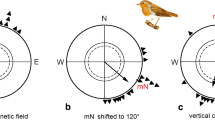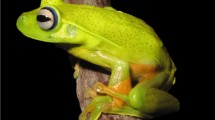Summary
Analyses of natural songs from the cricketTeleogryllus oceanicus confirm (after Hutchings and Lewis 1984) that the songs are rich in harmonics which extend up to around 55 kHz. A series of synthetic song models with a varying harmonic content were used to determine the relevance of these harmonics to the orientation behaviour of the insects.
In two-choice experiments in which song models were presented simultaneously, crickets showed a clear discrimination between a song with harmonics and a song without. Female insects orientated preferentially to a song with harmonics. Interestingly, males preferred a song model without harmonics in the two-choice situation.
Two experimental regimes were used to test orientation accuracy, a forced-choice (Y maze) phonotactic experiment and a study of free phonotaxis in the behavioural arena. The results of both experimental approaches confirm that crickets orientate more accurately to a song with harmonics and can discriminate smaller angles to sound sources ahead and lateral to the insect.
Presentations of song models in which the fundamental (5 kHz) was attenuated relative to the 2nd harmonic have given results that imply a process of neural integration (two-tone or side band suppression) of the fundamental and the high-frequency harmonics.
Similar content being viewed by others
Abbreviations
- see:
-
Methods
References
Bailey WJ (1985) Acoustic cues for female choice in bushcrickets (Tettigoniidae). In: Kalmring K, Elsner N (eds) Acoustic and vibrational communication in insects. Parey, Berlin Hamburg, pp 101–110
Bailey WJ, Thompson P (1977) Acoustic orientation in the cricketTeleogryllus oceanicus (Le Guillou). J Exp Biol 67:61–75
Boyan GS (1979) Directional responses to sound in the central nervous system of the cricketTeleogryllus commodus (Orthoptera: Gryllidae). I. Ascending interneurons. J Comp Physiol 130:137–150
Boyan GS (1980) Auditory neurones in the brain of the cricketGryllus bimaculatus (DeGeer). J Comp Physiol 140:81–93
Boyan GS (1981) Two-tone suppression of an identified auditory neurone in the brain of the cricketGryllus bimaculatus (DeGeer). J Comp Physiol 114:117-;25
Boyd P, Lewis B (1983) Peripheral auditory directionality in the cricket (Gryllus campestris L.,Teleogryllus oceanicus Le Guillou). J Comp Physiol 153:523–532
Boyd P, Kühne R, Silver S, Lewis B (1984) Two-tone suppression and song coding by ascending neurones in the cricketGryllus campestris L. J Comp Physiol A 154:423–430
Campbell DJ, Shipp E (1979) Regulation of spatial pattern in populations of the field cricketTeleogryllus commodus (Walker). Z Tierpsychol 51:260–268
Doolan JM, Pollack GS (1985) Phonotactic specificity of the cricketTeleogryllus oceanicus: intensity-dependent selectivity for temporal parameters of the stimulus. J Comp Physiol A 157:223–233
Esch H, Huber F, Wohlers DW (1980) Primary auditory neurones in crickets: Physiology and central projections. J Comp Physiol 137:27–38
Hill KG (1974) Carrier frequency as a factor in phonotactic behaviour of female crickets (Teleogryllus commodus). J Comp Physiol 93:7–18
Hutchings M, Lewis B (1984) The role of two-tone suppression in song coding by ventral cord neurones in the cricketTeleogryllus oceanicus (Le Guillou). J Comp Physiol A 154:103–112
Keuper A, Kühne R (1983) The acoustic behaviour of the bushcricketTettigonia cantans. II. Transmission of airbornesound and vibration signals in the biotope. Behav Proc 8:125–145
Larsen ON, Michelsen A (1978) Biophysics of the ensiferan ear. III. The cricket ear as a four-input system. J Comp Physiol 123:217–227
Lewis B (1983) Directional cues for auditory localization. In: Lewis B (ed) Bioacoustics. A comparative approach. Academic Press, London, pp 233–257
Michelsen A, Larsen ON (1983) Strategies for acoustic communication in complex environments. In: Huber F, Markl H (eds) Neuroethology and behavioural physiology. Springer, Berlin Heidelberg New York, pp 321–331
Moiseff A, Hoy RR (1983) Sensitivity to ultrasound in an identified auditory interneurone in the cricket: a possible neural link to phonotactic behavior. J Comp Physiol 152:155–167
Murphey RK, Zaretsky MD (1972) Orientation to calling song by female cricketsScapsipedus marginatus (Gryllidae). J Exp Biol 56:335–352
Nocke H (1972) Physiological apsects of sound communication in crickets (Gryllus campestris L.). J Comp Physiol 80:141–162
Oldfield BP (1980) Accuracy of orientation in female cricketsTeleogryllus oceanicus (Gryllidae): Dependence on song spectrum. J Comp Physiol 141:93–99
Pollack GS (1982) Sexual differences in cricket calling song recognition. J Comp Physiol 146:217–221
Pollack GS, Hoy RR (1981) Phonotaxis to individual rhythmic components of a complex cricket calling song. J Comp Physiol 144:367–373
Pollack GS, Huber F, Weber T (1984) Frequency and temporal pattern-dependent phonotaxis of crickets (Teleogryllus oceanicus) during tethered flight and compensated walking. J Comp Physiol A154:13–26
Popov AV, Shuvalov VF (1977) Phonotactic behavior of crickets. J Comp Physiol 119:111–126
Rheinlaender J, Blätgen G (1982) The precision of auditory lateralization in the cricket,Gryllus bimaculatus. Physiol Entomol 7:209–218
Rheinlaender J, Kalmring K, Popov AV, Rehbein H (1976) Brain projections and information processing of biologically significant sound by two large ventral-cord neurons ofGryllus bimaculatus DeGeer (Orthoptera, Gryllidae). J Comp Physiol 110:251–269
Schmitz B (1985) Phonotaxis inGryllus campestris L. (Orthoptera, Gryllidae). III. Intensity dependence of the behavioural performance and relative importance of tympana and spiracles in directional hearing. J Comp Physiol A156:165–180
Schmitz B, Scharstein H, Wendler G (1982) Phonotaxis inGryllus campestris L. (Orthoptera, Gryllidae). I. Mechanism of acoustic orientation in intact female crickets. J Comp Physiol 148:431–444
Stout JF, DeHaan CH, McGhee RW (1983) Attractiveness of the maleAcheta domesticus calling song to females. I. Dependence on each of the calling song features. J Comp Physiol 153:509–521
Thorson J, Weber T, Huber F (1982) Auditory behavior of the cricket. II. Simplicity of calling-song recognition inGryllus, and anomalous phonotaxis at abnormal carrier frequencies. J Comp Physiol 146:361–378
Wohlers DW, Huber F (1978) Intracellular recording and staining of cricket auditory interneurons (Gryllus campestris L.,Gryllus bimaculatus DeGeer). J Comp Physiol 127:11–28
Wohlers DW, Huber F (1982) Processing of sound signals by six types of neurons in the prothoracic ganglion of the cricket,Gryllus campestris L. J Comp Physiol 146:161–173
Author information
Authors and Affiliations
Rights and permissions
About this article
Cite this article
Latimer, W., Lewis, D.B. Song harmonic content as a parameter determining acoustic orientation behaviour in the cricketTeleogryllus oceanicus (Le Guillou). J. Comp. Physiol. 158, 583–591 (1986). https://doi.org/10.1007/BF00603802
Accepted:
Issue Date:
DOI: https://doi.org/10.1007/BF00603802




